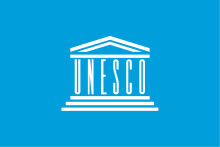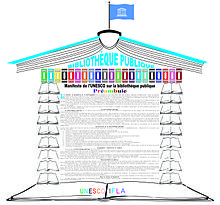
World Heritage Sites are landmarks and areas with legal protection by an international convention administered by UNESCO for having cultural, historical, or scientific significance. The sites are judged to contain "cultural and natural heritage around the world considered to be of outstanding value to humanity".
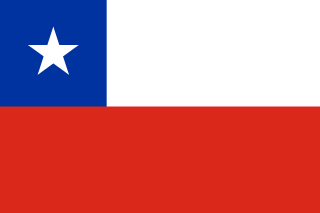
The flag of Chile consists of two equal-height horizontal bands of white and red, with a blue square the same height as the white band in the canton, which bears a white five-pointed star in the center. It was adopted on 18 October 1817. The Chilean flag is also known in Spanish as La Estrella Solitaria.
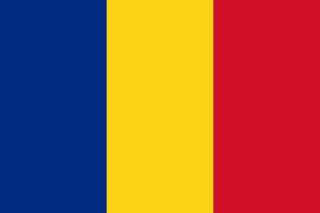
The national flag of Romania is a tricolour featuring three equal vertical bands colored blue, yellow and red, with a width to length ratio of 2:3.

The national flag of Sierra Leone is a tricolour consisting of three horizontal green, white and blue bands. It was adopted in 1961, Sierra Leone's independence year, to replace the British Blue Ensign defaced with the arms of the Crown Colony of Sierra Leone.

The national flag of Armenia, also known as the Tricolour, consists of three horizontal bands of equal width, red on the top, blue in the middle, and orange on the bottom. The Armenian Supreme Soviet adopted the current flag on 24 August 1990. On 15 June 2006, the Law on the National Flag of Armenia, governing its usage, was passed by the National Assembly of Armenia.

The flag of American Samoa consists of a red-edged white triangle pointing towards the hoist charged with a bald eagle clutching a war club and fly-whisk, with dark blue upper and lower triangles. Adopted in April 1960 to replace the "Stars and Stripes" as the official flag of the territory, it has been the flag of the Territory of American Samoa since that year. The colors used epitomize the traditional colors of the United States and Samoa.

The flag of Barbados was designed by Grantley W. Prescod and was officially adopted to represent the nation of Barbados at midnight on 30 November 1966, the day the country gained independence. The flag was chosen as part of a nationwide open contest held by the government, with Prescod's design being selected as the winner of a field of over one thousand entries. The flag is a triband design, with the outermost stripes coloured ultramarine, to represent the sea and the sky, and the middle stripe coloured gold, to represent the sand. Within the middle band is displayed the head of a trident. This trident is meant to represent the trident of Poseidon, visible in Barbados's colonial coat of arms, and the fact that it is broken is meant to represent the breaking of colonial rule in Barbados and independence from the British Empire.

The national flag of Bosnia and Herzegovina contains a medium blue field with a yellow right triangle separating said field, and there are seven full five-pointed white stars and two half stars top and bottom along the hypotenuse of the triangle.
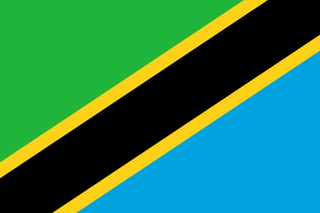
The national flag of Tanzania consists of a Gold-edged black diagonal band, divided diagonally from the lower hoist-side corner, with a green upper triangle and light blue lower triangle. Adopted in 1964 to replace the individual flags of Tanganyika and Zanzibar, it has been the flag of the United Republic of Tanzania since the two states merged that year. The design of the present flag incorporates the elements from the two former flags. It is one of a relatively small number of national flags incorporating a diagonal line, with other examples including the DR Congo, Republic of the Congo, Namibia, Saint Kitts and Nevis, Trinidad and Tobago and Brunei.

The flag of the United Nations is a sky blue banner containing the United Nations' emblem in the centre. The emblem on the flag is coloured white; it is a depiction of the world map in the azimuthal equidistant projection, surrounded by a pair of olive branches. The emblem was officially adopted on 7 December 1946, and the flag containing the emblem was officially adopted on 20 October 1947.

The flag of NATO consists of a dark blue field charged with a white compass rose emblem, with four white lines radiating from the four cardinal directions. Adopted three years after the creation of NATO, it has been the flag of NATO since October 14, 1953. The blue color symbolizes the Atlantic Ocean, while the circle stands for unity.

The Turkmen people have traditionally been nomads and equestrians, and even today after the fall of the USSR attempts to urbanize the Turkmens have not been very successful. They never really formed a coherent nation or ethnic group until they were forged into one by Joseph Stalin in the 1930s. Rather they are divided into clans, and each clan has its own dialect and style of dress. Turkmens are famous for making knotted Turkmen carpets, often mistakenly called "Bukhara rugs" in the West. These are elaborate and colorful hand-knotted carpets, and these too help indicate the distinctions among the various Turkmen clans.
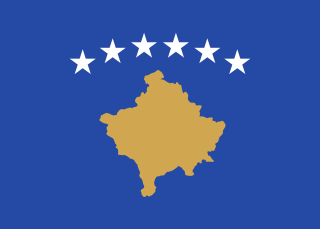
The flag of the Republic of Kosovo was adopted by the Assembly of the Republic of Kosovo immediately following the unilateral declaration of independence of Kosovo on 17 February 2008. The flag design emerged from an international competition, organized by an informal group from the Provisional Institutions of Self-Government known as the Kosovo Unity Team, which attracted almost one thousand entries. The winning design was proposed by Muhamer Ibrahimi. It shows six white stars in an arc above a golden map of Kosovo, all on a blue field. The stars symbolize Kosovo's six major ethnic groups: Albanians, Serbs, Bosniaks, Turks, Romani, and Gorani.

The World Heritage Convention, formally the Convention Concerning the Protection of the World Cultural and Natural Heritage, is an international treaty signed on 23 November 1972, which created the World Heritage Sites, with the primary goals of nature conservation and the preservation and security of cultural properties. The convention, a signed document of international agreement, guides the work of the World Heritage Committee. It was developed over a seven-year period (1965–1972).
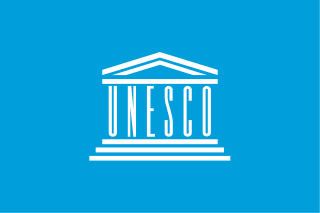
The United Nations Educational, Scientific and Cultural Organization is a specialized agency of the United Nations (UN) with the aim of promoting world peace and security through international cooperation in education, arts, sciences and culture. It has 194 member states and 12 associate members, as well as partners in the non-governmental, intergovernmental and private sector. Headquartered in Paris, France, UNESCO has 53 regional field offices and 199 national commissions.

Cultural property, also known as cultural patrimony, comprises the physical items that are part of the cultural heritage of a group or society, as opposed to less tangible cultural expressions. They include such items as cultural landscapes, historic buildings, works of art, archaeological sites, as well as collections of libraries, archives, and museums.
Mapuche flag is each of the flags used as an emblem and symbol of the Mapuche Nation and the Mapuche communities and organizations in Chile and Argentina. There are several different flags representing the Mapuche communities and territories.

The city flag of San Antonio, Texas was originally drawn by Spanish–American War veteran William W. Herring on May 28, 1933. The design saw significantly more usage than the official flag, but was never officially adopted until 1976. The current flag is a slightly modified version of Herring's design, most notably removing the text formerly displayed.
The flag of Earth is a concept of a possible flag design meant to symbolize the planet Earth, humankind, or a possible world government.
